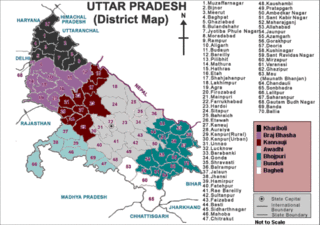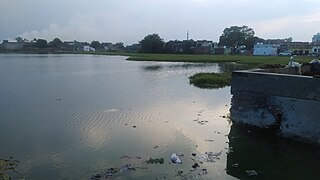Related Research Articles

The Partition of India in 1947 was the change of political borders and the division of other assets that accompanied the dissolution of the British Raj in South Asia and the creation of two independent dominions: India and Pakistan. The Dominion of India is today the Republic of India, and the Dominion of Pakistan—which at the time comprised two regions lying on either side of India—is now the Islamic Republic of Pakistan and the People's Republic of Bangladesh. The partition was outlined in the Indian Independence Act 1947. The change of political borders notably included the division of two provinces of British India, Bengal and Punjab. The majority Muslim districts in these provinces were awarded to Pakistan and the majority non-Muslim to India. The other assets that were divided included the British Indian Army, the Royal Indian Navy, the Royal Indian Air Force, the Indian Civil Service, the railways, and the central treasury. Self-governing independent India and Pakistan legally came into existence at midnight on 14–15 August 1947.
Muzaffarnagar is a city under Muzaffarnagar District in the Indian State of Uttar Pradesh. It is situated midway on the Delhi - Haridwar/Dehradun National Highway and is also well connected with the national railway network. It is known as the sugarbowl of Uttar Pradesh.
In the Bombay riots in December 1992 and January 1993, an estimated 900 people died. The riots were mainly due to escalations of hostilities after large scale protests by Muslims in reaction to the 1992 Babri Masjid Demolition by Hindu Karsevaks in Ayodhya; and by Hindu mobs in regards with the Ram Temple issue.
Thana Bhawan is a small town in Shamli district in the Indian state of Uttar Pradesh. District Shamli is a newly constructed district. Before becoming a new district, it came under district Muzaffarnagar and was well known tehsil of it. It was known as Prabuddhnagar first time, when this district came into focus. It is situated on Delhi–Shamli national highway, it is 100 km away from Delhi, 65 km from Saharanpur, 38 km from Muzaffarnagar and only 59.6 km away from Panipat (Haryana). Border of this district is connected with district Muzaffarnagar in east and with Haryana in west and with Saharanpur in north and with district Baghpat it is connected in south. It is said that the name Thana Bhawan emerged from the name of Devi Bhawan Temple. In the 18th century it was home to mostly Hindu and Muslims families. It is situated on the Delhi–Saharanpur highway NH 709B around 120 kilometres (75 mi) from Delhi.
Kairana is a city and a municipal board in Shamli district of the Indian state of Uttar Pradesh. It is approximately 14 km (8.7 mi) from Shamli city.

The 2002 Gujarat riots, also known as the 2002 Gujarat violence, was a three-day period of inter-communal violence in the western Indian state of Gujarat. The burning of a train in Godhra on 27 February 2002, which caused the deaths of 58 Hindu pilgrims and karsevaks returning from Ayodhya, is cited as having instigated the violence. Following the initial riot incidents, there were further outbreaks of violence in Ahmedabad for three months; statewide, there were further outbreaks of violence against the minority Muslim population of Gujarat for the next year.
Kawal is a village in the Muzaffarnagar district of western Uttar Pradesh in northern India. When it comes to western Uttar Pradesh, Kaval cannot be forgotten. Kawal is a town situated in the Tehsil Janasath of Muzaffarnagar district, which was once famous for its Tehzeeb in the name of Chhota Lucknow in Hindustan. This village was founded by the Nawab Munshi of Kawal. Bashir and Khan Sahab Abdurrahman's ancestors
The Nellie massacre took place in central Assam during a six-hour period in the morning of 18 February 1983. The massacre claimed the lives of 1,600–2,000 people from 14 villages—Alisingha, Khulapathar, Basundhari, Bugduba Beel, Bugduba Habi, Borjola, Butuni, Dongabori, Indurmari, Mati Parbat, Muladhari, Mati Parbat no. 8, Silbheta, Borburi and Nellie—of Nagaon district. The victims were Muslim peasants of East Bengal origin. Three media personnel—Hemendra Narayan of Indian Express, Bedabrata Lahkar of Assam Tribune and Sharma of ABC—were witnesses to the massacre.
Religious violence in India includes acts of violence by followers of one religious group against followers and institutions of another religious group, often in the form of rioting. Religious violence in India has generally involved Hindus and Muslims.

The Noakhali riots were a series of semi-organized massacres, rapes and abductions, combined with looting and arson of Hindu properties, perpetrated by the Muslim community in the districts of Noakhali in the Chittagong Division of Bengal in October–November 1946, a year before India's independence from British rule.

Western Uttar Pradesh is a region in India that comprises the western districts of Uttar Pradesh state, including the areas of Rohilkhand and those where Khariboli, Braj and Kannauji are spoken. The region has some demographic, economic and cultural patterns that are distinct from other parts of Uttar Pradesh, and more closely resemble those of Haryana and Rajasthan states. Western Uttar Pradesh has experienced rapid economic growth, in a fashion similar to Haryana and Punjab, due to the successes of the Green Revolution. A significant part of western Uttar Pradesh is a part of National Capital Region of India. The largest city of the region is Ghaziabad, while the second-largest city, Agra, is a major tourist destination.

Shamli is a district in the Indian state of Uttar Pradesh. This district was carved out from Muzaffarnagar District on 28 September 2011 as Prabudh Nagar and renamed Shamli in July 2012. Shamli is the headquarters of the district. Shamli is located along the Delhi–Saharanpur, Meerut-Karnal and Panipat-Khatima Highways.

The Bhagalpur violence of 1989 took place between Hindus and Muslims in the Bhagalpur district of Bihar, India. The violence started on 24 October 1989, and the violent incidents continued for 2 months, affecting the Bhagalpur city and 250 villages around it. Over 1,000 people were killed, and another 50,000 were displaced as a result of the violence. It was the worst instance of Hindu-Muslim violence in independent India at the time.

The clashes between the Hindu and Muslim communities in Muzaffarnagar district of Uttar Pradesh, India in August–September 2013, resulted in at least 62 deaths including 42 Muslims and 20 Hindus and injured 93 and left more than 50,000 people displaced. By date 17 September, the curfew was lifted from all riot affected areas and the army was also withdrawn.
There have been several instances of religious violence against Muslims since the partition of India in 1947, frequently in the form of violent attacks on Muslims by Hindu nationalist mobs that form a pattern of sporadic sectarian violence between the Hindu and Muslim communities. Over 10,000 people have been killed in Hindu-Muslim communal violence since 1950 in 6,933 instances of communal violence between 1954 and 1982.
Suresh Kumar Rana(alias Suresh Kumar) is a politician based in western Uttar Pradesh. He was a member of the 16th Legislative Assembly of Uttar Pradesh and is currently a member of 17th Legislative Assembly of Uttar Pradesh in the northern state of India. He represents the Thana Bhawan constituency of Uttar Pradesh and is a member of the Bharatiya Janata Party. Rana has previously served as a Minister of State (Independent Charge) in the Uttar Pradesh Government and currently holds the position of a Cabinet Minister in the Yogi Adityanath led Government and holds the portfolios of sugarcane development and sugarcane mills.
Kairana and Kandhla migration row refers to persecution and mass migration of Hindu families from Kairana and Kandhla in the Indian state of Uttar Pradesh during the period 2014–16. Media sources have stated that the migration was due to threats of extortion from a Muslim Extremist Mukim Kala, described as a "gangster." NHRC reports and accounts of several eyewitnesses also states that the Muslims in Kairana town pass lewd/taunting remarks against Hindu females and due to this, they avoid going outside frequently.
In India, cow vigilante violence is the use of physical force in the name of "cow protection". Since 2014, mob attacks targeting mostly illegal cow smugglers, but in some cases even licensed cow traders, have become prominent. There is a debate on whether there has actually been any change in the number of such incidences, as government data points out to reduced communal tensions post 2014. Cattle slaughter is banned in most states of India. Recently emerged cow vigilante groups, claiming to be protecting cattle, have been violent leading to a number of deaths. Cow-protection groups see themselves as preventing cattle theft and smuggling, protecting the cow or upholding the law in an Indian state which bans cow slaughter. According to a Reuters report, a total of 63 cow vigilante attacks had occurred in India between 2010 and mid 2017, most after Prime Minister Narendra Modi came to power in 2014. In these attacks between 2010 and June 2017, "28 Indians – 24 of them Muslims – were killed and 124 injured", states the Reuter's report.

The 2020 Delhi riots, or North East Delhi riots, were multiple waves of bloodshed, property destruction, and rioting in North East Delhi, beginning on 23 February 2020 and caused chiefly by Hindu mobs attacking Muslims. Of the 53 people killed, two-thirds were Muslims who were shot, slashed with repeated blows, or set on fire. The dead also included a policeman, an intelligence officer and over a dozen Hindus, who were shot or assaulted. More than a week after the violence had ended, hundreds of wounded were languishing in inadequately staffed medical facilities and corpses were being found in open drains. By mid-March many Muslims had remained missing.
References
- ↑ "The Lingering Pain Of Muzaffarnagar". Outlook. 9 September 2016. Retrieved 22 September 2016.
- 1 2 "Muzaffarnagar riots: 30,000 people still living in 65 refugee colonies". Asian Age. 8 September 2016. Retrieved 22 September 2016.
- 1 2 "Riot victims live in ghetto-like conditions: Report". The Hindu. 8 September 2016. Retrieved 22 September 2016.
- ↑ "Muzaffarnagar, three years later". Indian Express. 7 September 2016. Retrieved 22 September 2016.
- ↑ "30000 riot displaced off govt's radar". The Telegraph. 8 September 2016. Archived from the original on 9 September 2016. Retrieved 22 September 2016.